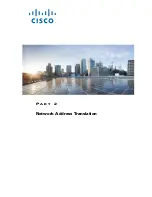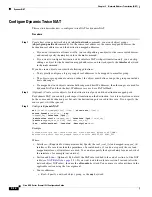
9-4
Cisco ASA Series Firewall CLI Configuration Guide
Chapter 9 Network Address Translation (NAT)
NAT Basics
Note
For static NAT, the rule is bidirectional, so be aware that “source” and “destination” are used in
commands and descriptions throughout this guide even though a given connection might originate at the
“destination” address. For example, if you configure static NAT with port address translation, and
specify the source address as a Telnet server, and you want all traffic going to that Telnet server to have
the port translated from 2323 to 23, then in the command, you must specify the
source
ports to be
translated (real: 23, mapped: 2323). You specify the source ports because you specified the Telnet server
address as the source address.
The destination address is optional. If you specify the destination address, you can either map it to itself
(identity NAT), or you can map it to a different address. The destination mapping is always a static
mapping.
Twice NAT also lets you use service objects for static NAT with port translation; network object NAT
only accepts inline definition.
Comparing Network Object NAT and Twice NAT
The main differences between these two NAT types are:
•
How you define the real address.
–
Network object NAT—You define NAT as a parameter for a network object. A network object
names an IP host, range, or subnet so you can then use the object in the NAT configuration
instead of the actual IP addresses. The network object IP address serves as the real address. This
method lets you easily add NAT to network objects that might already be used in other parts of
your configuration.
–
Twice NAT—You identify a network object or network object group for both the real and
mapped addresses. In this case, NAT is not a parameter of the network object; the network object
or group is a parameter of the NAT configuration. The ability to use a network object
group
for
the real address means that twice NAT is more scalable.
•
How source and destination NAT is implemented.
–
Network object NAT— Each rule can apply to either the source or destination of a packet. So
two rules might be used, one for the source IP address, and one for the destination IP address.
These two rules cannot be tied together to enforce a specific translation for a source/destination
combination.
–
Twice NAT—A single rule translates both the source and destination. A matching packet only
matches the one rule, and further rules are not checked. Even if you do not configure the
optional destination address for twice NAT, a matching packet still only matches one twice NAT
rule. The source and destination are tied together, so you can enforce different translations
depending on the source/destination combination. For example, sourceA/destinationA can have
a different translation than sourceA/destinationB.
•
Order of NAT Rules.
–
Network object NAT—Automatically ordered in the NAT table.
–
Twice NAT—Manually ordered in the NAT table (before or after network object NAT rules).
Содержание ASA 5508-X
Страница 11: ...P A R T 1 Access Control ...
Страница 12: ......
Страница 60: ...4 14 Cisco ASA Series Firewall CLI Configuration Guide Chapter 4 Access Rules History for Access Rules ...
Страница 157: ...P A R T 2 Network Address Translation ...
Страница 158: ......
Страница 204: ...9 46 Cisco ASA Series Firewall CLI Configuration Guide Chapter 9 Network Address Translation NAT History for NAT ...
Страница 232: ...10 28 Cisco ASA Series Firewall CLI Configuration Guide Chapter 10 NAT Examples and Reference DNS and NAT ...
Страница 233: ...P A R T 3 Service Policies and Application Inspection ...
Страница 234: ......
Страница 379: ...P A R T 4 Connection Management and Threat Detection ...
Страница 380: ......
Страница 400: ...16 20 Cisco ASA Series Firewall CLI Configuration Guide Chapter 16 Connection Settings History for Connection Settings ...
Страница 414: ...17 14 Cisco ASA Series Firewall CLI Configuration Guide Chapter 17 Quality of Service History for QoS ...











































